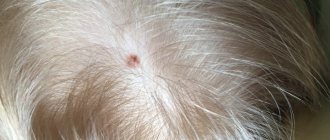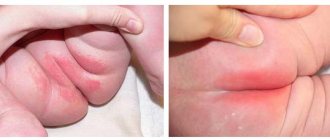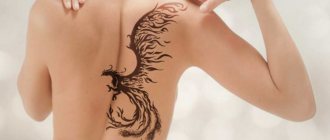A boil on the head in the hair occurs due to infection with staphylococci, streptococci or fungi. It appears as a cone-shaped lump filled with pus.
Despite the fact that the problem is usually invisible to others, it usually causes significant discomfort: the patient feels throbbing pain, which intensifies when touching the affected area; in addition, severe headaches, dizziness, fever, weakness, and general deterioration of health often occur.
Why do acne appear on the scalp of women?
Acne on any part of the body appears due to excessive work of the sebaceous glands in a specific place, the hair follicles become clogged and pimples appear that are unpleasant in appearance and feel. But the cause of hyperactivity of the sebaceous glands can be various factors: improper care of the scalp, external influences, internal hormonal changes.
In this article we will look at the most serious reason for the formation of acne on the head of women - hormonal disorders.
Pimples on the scalp can appear in people of any gender and age. Today, acne is not a disease of teenagers, as previously thought; it can happen at any age for a variety of reasons.
The inflammations we call acne can have different appearances:
- inflammation from pink to purple in the form of tubercles on the scalp;
- inflammation from pale yellow to deep yellow (purulent inflammation);
- closed white tubercles that do not open on their own;
- “black spots” may occur.
Some inflammations go away on their own and leave no traces, but large ones, with pus inside, leave scars on the skin after opening and drying.
Treatment methods
The doctor determines treatment tactics individually based on the etiology of formations in the hair and the stage of development of abscesses on the head. Therapy should have a comprehensive effect on the body:
- nutrition correction;
- immunostimulating therapy;
- elimination of allergens;
- selection of detergents from the pharmacy for hair hygiene;
- rejection of bad habits.
The main therapeutic measures consist of conservative medication, traditional medicine recipes, and, if necessary, surgery to open an abscess in the hair on the head.
Medication
A conservative method of treating formations on the head involves taking oral medications and dosage forms for topical application to the hair.
| Name of drugs | Mechanism of action |
| Antibacterial tablets - Erythromycin, Amoxicillin. | Prescribed for extensive, large lesions, penetration of bacteria into the blood, and influence the cause of the pathology. |
| Antibiotic ointments – Levomekol, Sintomycin, Tetracycline, Clindamycin spray, Mupirocin. | Local elimination of ulcers on the head with shallow lesions. They help quickly get rid of acne in the hair without involving other body systems in the process. |
| Antifungal drugs – Clotrimazole, Fluconazole, Fusidine. | With a proven fungal etiology, the lesions are effectively eliminated. |
| Anti-allergenic - Loratadine, Zodak, Eden. | The drugs fight the manifestations of an allergic reaction by stabilizing inflammatory mediators. |
| For stress etiology of ulcers in the hair - Glycine, Persen. | Prescribed by a neurologist to stabilize psychological comfort. |
| Preparations based on estradiol. | Prescribed by a gynecologist-endocrinologist to stabilize hormonal levels in women. |
| Antiseptics – Chlorhexidine, Hydrogen peroxide 3%, Fukortsin. | For disinfection, drying out rashes on the head, preventing new ulcers. |
| Sorbents – Enterosgel, Polysorb, Sekta, White Coal, Laktofiltrum. | They help remove toxins, stabilize the immune system, and eliminate the internal causes of formations in the hair. |
The optimal complex use of drugs is a combination of antibiotics, immunomodulators, local antiseptics for a positive effect in the treatment of ulcers.
Surgical
Opening abscesses in the hair on the head is advisable in the absence of the effect of conservative treatment, the development of a large carbuncle, or abscess formation of the pathology.
The operation to excise the abscesses is performed under local anesthesia. During surgery, the doctor opens the abscess in the hair, removes the necrotic core, inspects the wound, and washes it with antiseptics. At the end, drainage is installed for 2-3 days. If there is no need for drainage, the wound on the head is tightly sutured, and a sterile bandage is applied over it.
Traditional methods
You can treat purulent acne on the head using traditional methods only after consulting a doctor. In complex therapy, home recipes have anti-inflammatory, antiseptic, and wound-healing effects.
For ulcers, lotions, decoctions, and head compresses are used:
- rinsing hair with apple cider vinegar diluted in equal proportions with water;
- adding 1-2 drops of essential oils of almond, peach, tea tree to the shampoo;
- rubbing oil vitamins A and E into the scalp;
- mask of cinnamon, honey, flour - 1 tbsp. l. Stir the ingredients to a paste, dilute with a little water, apply for 30 minutes, then rinse thoroughly with running water;
- compress from the pulp of a baked onion - apply a gauze bandage to the area of the abscess overnight;
- a thick soap solution with 72% laundry soap - rub into the sore overnight without rinsing;
- rinsing with herbal decoctions - chamomile, sage, thyme, honey, cornflower.
Traditional methods for ulcers help in the initial stages of the disease in the scalp.
Hormonal causes of acne on the head
A failure in the production of one of the hormones in the human body can lead to malfunction of the entire system, including disturbances in the production of sebum on the head and the appearance of rashes, both abundant and not too much. In addition to acne, a number of factors can also indicate the presence of hormonal imbalance:
- absence of the menstrual cycle or its variability;
- a history of a diagnosis of polycystic disease or PCOS;
- Excessive male pattern body hair growth;
- painful menstruation;
- spotting outside the cycle;
- decreased libido and more.
The most common disorders in a woman’s hormonal system, which can cause acne on the head:
- insufficient function of the thyroid gland - hypothyroidism (with this diagnosis, less thyroid hormones are produced than the body needs);
- hyperfunction of the thyroid gland - hyperthyroidism (thyroid hormones are produced significantly more than the body needs);
- increased production of testosterone and the hormone DHEA;
- increased levels of prolactin in the blood serum;
- It is also necessary to control the level of insulin in the blood; if there is too much of it, metabolic processes in the body are disrupted.
There can be many reasons for dysfunction; high-quality diagnostics are needed to understand what to treat.
Symptoms of bumps with pus in the hair
The initial stage of damage to the hair on the head with the formation of an abscess begins when a bacterium penetrates into healthy tissue and a dense inflammatory infiltrate is formed. The development of a pimple is accompanied by redness around it, and a white covering forms on the surface of the abscess.
Need advice from an experienced doctor?
Get a doctor's consultation online. Ask your question right now.
Ask a free question
At the initial stage, the size of the abscess does not exceed 0.6-10 mm, the shape is regular round. With the progression of the pathology, the focus of suppuration in the hair grows, changing its outline, and clinical symptoms appear:
- pain, which intensifies with pressure, can radiate to the neck, jaw, and facial area;
- itching, worse at night;
- after wearing a headdress, you may experience a feeling of discomfort and tightness of the skin on your head;
- local hyperemia;
- increase in general body temperature;
- deterioration of the condition with the development of weakness, drowsiness or irritability, nervousness;
- headache;
- sensory organ disorders – hearing impairment, visual disturbances.
If characteristic symptoms appear, you must consult a doctor to diagnose the condition and prescribe treatment.
It is dangerous to self-medicate due to the risk of complications of ulcers on the scalp.
Diagnosis
To begin correct and effective treatment, it is necessary to make a correct diagnosis. If acne appears on the scalp, it is better to visit an endocrinologist who can assess the problem and prescribe the necessary tests.
I, Romanov Georgy Nikitich, offer my services for the diagnosis and treatment of acne on the head of women. I am an experienced endocrinologist with more than 20 years of experience, practicing in a clinic and also conducting online consultations. My experience, which I have gained over the years of working in private clinics, hospitals, foreign medical institutions (Germany, Great Britain, France), allows me to treat patients with maximum efficiency and put diseases into remission.
If the cause of acne is hormonal problems, then diagnostics will help identify them:
- clinical blood test;
- basic blood biochemistry;
- blood test for the concentration of thyroid hormones;
- Ultrasound of the thyroid gland;
- assess the function of the reproductive system (ultrasound of the pelvic organs in women, blood tests for sex hormones).
Further research may be necessary.
Preventive measures
To properly cleanse the skin, you need to exfoliate once a week.
To prevent purulent rashes in the future, you need to carefully monitor your own health.
Prevention will help avoid skin problems:
- eat a fully balanced diet;
- spend more time outdoors;
- adhere to the rules of personal hygiene;
- limit yourself to drinking alcohol and coffee;
- refuse hats made of synthetic fabric;
It is important to use only high-quality hair and scalp care products.
Prevention
Most often, hormonal imbalances occur in women due to the mobility of their hormonal system (every cycle a certain hormonal pathway occurs). To protect yourself from thinking: “What organ is wrong with me if acne appears on my head?”, women need to monitor their diet, sleep, be stress-resistant, and also not skip annual medical examinations.
Remember: it is better to prevent a disease than to treat it. And if you treat, then at the very beginning.
Possible complications
The appearance of purulent formations on the head can lead to serious consequences. Against the background of abundant proliferation of blood vessels, infection of the brain is possible. There is also a risk of other complications:
- formation of abscesses on the face;
- generalization of suppuration;
- the appearance of abscesses;
- development of phlebitis of the facial veins.
Month-old infants are at risk of developing meningitis, as ulcers often affect the lining of the brain. Refusal of treatment often leads to the development of sepsis, which in turn can cause death.
Types of pyoderma
The disease is classified depending on the type of pathogen, as well as on the nature of the course. In the first case, streptoderma and staphyloderma are distinguished, in the second - acute and chronic pyoderma.
Staphyloderma is divided into:
- Superficial (ostiofolliculitis, superficial folliculitis, etc.).
- Deep (for example, carbuncle or deep folliculitis).
It is staphylococcal lesions that usually involve hair follicles and sweat glands. Streptoderma most often affects smooth skin. They can also be deep or superficial. In addition, a fungal component is often associated with the disease, which complicates its course.
Message sent!
Signs of wound formation
During the formation of pathology, the inner wall of the skin is damaged, which contributes to some manifestations:
- the formation of wounds of various sizes as a result of the development of pathology, which cause acute pain, causing discomfort for the patient;
- redness and formation of an inflammatory process around existing wounds;
- small wounds are formed as a result of complications after mechanical trauma, gradually destroying the internal covering and forming large wounds;
Characteristic signs of the presence of wounds on the foreskin, without visual manifestations, are pain when urinating and exposure of the head. Sexual intercourse is also accompanied by discomfort and pain.
Patients experiencing such problems should not aggravate the situation and, if possible, protect themselves from provoking factors in order to avoid serious complications.
Useful information on problems related to the foreskin and urology:
- Calling a urologist to your home
- Balanitis
- Balanoposthitis
- Frenum plastic surgery
- Urethral swab
- Prostate massage
- Circumcision
- Tests for STIs
- Treatment of sexually transmitted diseases
- Ultrasound at home
- Frenum of the penis
- Pyelonephritis
- Ultrasound of the bladder
- Diagnosis of sexually transmitted infections
- How to prepare for an appointment with a urologist?
- How to get tested for urological diseases?
- What tests can be done by a urologist?
- What diseases does a urologist treat?
- What symptoms should you consult a urologist for?
- How to make an appointment with a urologist at the clinic?
- Consultation with a urologist
- Diagnosis of urological diseases
- Examination by a urologist
- Treatment of urological diseases
- Appointment with a urologist
- Urology - the science of men's health
- Pediatric urologist
- Male doctor
- Paid urologist








